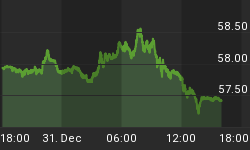Economic data does not seem to matter to the bond market anymore, bonds just keep flying off the shelves like they are going out of style. Long bonds under 4.5%, 10 years near 4%, long real yields closing in on 0%, but the sellers have gone on strike. Even with corporate spreads stabilizing and the stock market bouncing in convincing fashion, sellers of US Treasuries have gone underground. On the other hand, we had Big Bad Bill Gross, the Bond King, stepping up to confess last week that PIMCO has given up on their bearish outlook after close to 2 years of fighting the bull market. Bonds just lost their largest buyer. Could this be the sign of a temporary top? If it is a top, I am still quite comfortable with the idea of a temporary top as I believe that yields will still be heading considerably lower longer term.
NOTEWORTHY: We had a busy week on the economic data release front. The inflation data was mostly higher than expected, with the exception of the core CPI, which was unchanged in April after a hefty 0.4% increase in March. Bonds paid no attention whatsoever to the higher than expected PPI (both headline and core) numbers. Housing is still strong, but Industrial Production was not (but the stock market decided to ignore that as it was strictly an auto sector problem). The fact that Capacity Utilization (including all sectors, not just autos) is still well below 80% did not seem to bother stocks or corporate bonds either. Leading Economic Indicators - as measured by the Conference Board - are down 1.1% year over year now. Wall Street says that indicator is broken and needs to be replaced. I am personally of the opinion that some of the Wall Street people that think that LEI is broken are the ones that need to be replaced. In the meantime, The Philly Fed survey plunged a cool 18 points last month, in order to move in line with the ugly story that LEI and most of the Consumer and Industrial Surveys are telling us. Next week will be quiet on the data front, Durables on Wednesday and Q1 GDP revision on Thursday are the notable minor releases that will keep us amused before the long weekend and the fireworks the week following.
INFLUENCES: Fixed income portfolio managers have been steady bearish. (RT survey for the latest week was up a point to 42% bullish. This metric is somewhat bullish from a contrarian perspective.) The 'smart money' commercials are still long 302k contracts (the second small weekly increase from last week's 290k). This number is also somewhat supportive for bonds. Seasonals are strongly positive after the second week in May. On the technical front, we are closing in on 4% on the US 10 year notes. This level has proven to be the bottom of the recent trading range in 10 years. I believe it will be difficult to breach the 4% level on a lasting basis without some compelling fundamental evidence.
RATES: US Long Bond futures closed at 115-31, up 10 ticks on the week, while the yield on the US 10-year note was practically unchanged at 4.12% after trading as low as 4.07%. My bias is neutral, and I can't believe I even considered shorting this conundrum. The Canada - US 10 year spread were in by 5 to -3 basis points. We are officially neutral on this spread at this point, but leaning towards selling Canada to buy US bonds. Dec05 BA futures closed the week 82 basis points through Dec05 EuroDollar futures, which was in 9 basis points from last week's close. At 62 it was an official trade recommendation to buy EDZ5 to sell BAZ5. The belly of the Canadian curve outperformed the wings by 3 bps last week as the belly is outperforming the wings on the rally. Selling Canada 3.25% 12/2006 and Canada 5.75% 6/2033 to buy Canada 5.25% 6/2012 was at a pick-up of 45 basis points. Assuming an unchanged curve, considering a 3-month time horizon, the total return (including roll-down) for the Canada bond maturing in 2011 is the best value on the curve. In the long end, the Canada 8% bonds maturing on June 1, 2023 are dirt cheap.
CORPORATES: Corporate bond spreads were mixed last week. Long TransCanada Pipeline bonds were in 1 basis point to 128, while long Ontario bonds were also in 1.0 to 51. A starter short in TRAPs was recommended at 102 back in February 2004. Corporates are settling down somewhat, as expected before the next shoe drops. Shorter maturity, quality corporates should be favoured over lower rated issues as I believe corporate spreads will continue to be under pressure. Any credit that is connected with the consumer and discretionary spending should be avoided. Corporate spreads have widened considerably, so a pause and perhaps a bounce is due during the next 4-6 weeks. Look to sell the bounce.
BOTTOM LINE: Neutral continues to be the operative word on bonds. A trading short was recommended for aggressive short term oriented accounts 2 weeks ago, but that was a mistake. An overweight position in the belly of the curve is still recommended for Canadian accounts. Short exposure for the corporate sector is advised. After a brief pause, this sector is expected to move substantially wider going forward. Sell BAZ5 to buy EDZ5 at a pick-up of 62 bps or better was recommended a few weeks back.
GENERAL COMMENTS: In addition to a softer commodity market and a "broken" LEI that predicts gloom and doom, it appears that shipping company stocks as well as shipping rates such as the Baltic Dry Freight Index are looking decidedly sick at this juncture in time. Caution is advised.
















